News
 81
81Translation Requirements for XML Serialization have been Relaxed in Compliance with WIPO ST.26 Standards – With the Changes Effective Immediately
TIPO has implemented the WIPO ST.26 standard since August 1, 2022. In order to enhance the convenience of preparing Chinese translations of XML sequences and expedite the application process, we have relaxed the Chinese translation requirements for XML sequences, effective immediately. Only the invention title, applicant, and inventors need to be translated into Chinese. Other specific limited term contents are no longer required to be translated. For applications notified by TIPO of any missing Chinese translations in the XML sequence, if they meet the criteria of the relaxed requirements, they will also be applicable for the changes.TIPO suggests that patent applications in languages other than Chinese, which include nucleotide or amino acid sequences, should also include a separate XML English sequence listing. This recommendation aims to facilitate the identification of the date on which the necessary documentation is complete and the following examination. The Implementation of WIPO ST.26 Standard Q&A had been revised accordingly.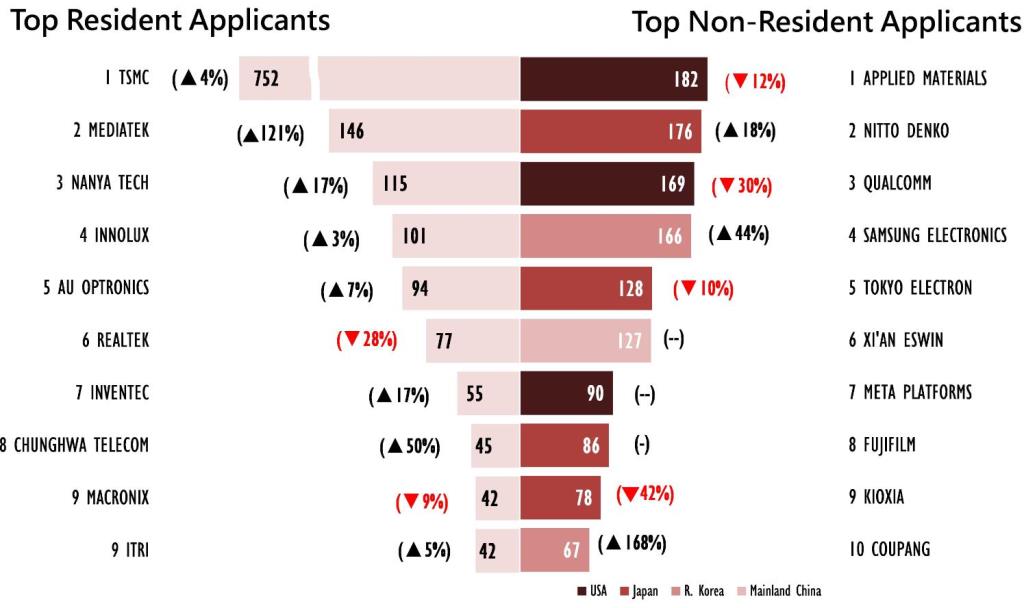 82
82TIPO’s Q1 2023 IPR Statistics Report
In Q1 2023, TIPO received a total of 17,226 patent applications (including invention, utility model, and design patents), marking a 2% decrease over the same period last year. Of these, the number of invention patent applications (12,486 cases) remained steady. Trademark applications stood at 21,494 cases, with a drop of 4%. As for invention patent applicants, TSMC ranked first (752 cases) among resident applicants, while Applied Materials (182 cases) led all non-resident applicants. The top resident and non-resident trademark applicants were Uni-President (102 cases) and Saic-Gm-Wuling Automobile (84 cases), respectively.Patent ApplicationsCompared to the same period (Q1) last year, overall patent applications (17,226 cases) received by TIPO saw a decrease of 2%. Of these, invention patents, most applications filed among overall patents, stood at 12,486 cases, with a slight decrease of 0.4%. Both resident applications (4,637 cases) and non-resident applications (7,849 cases) remained relatively unchanged. The number of utility model patent applications also decreased. On the other hand, design patents (1,654 cases) were up by 1%, thanks to the 6% increase contributed by foreign applicants (Table 1).As for the top 10 resident applicants for invention patent filings, TSMC filed the most invention patent applications (752 cases), setting its all-time-high record and outnumbering other domestic applicants for four straight years. Mediatek (146 cases) saw the highest growth rate with 121%; Innolux filed 101 applications, setting its new historical record by exceeding 100 cases (Figure 2).In terms of resident applicants for design patent filings, Acer claimed the top spot again with 24 cases. Both Ant Creative (16 cases) and Hotek (12 cases) filed for the first time and entered the top 5 list at the same time (Figure 3).The number of invention patent applications from domestic enterprises (3,817 cases) and research institutions (83 cases) grew by 2% and 9%, respectively. On the other hand, the number of applications from colleges and universities (341 cases) decreased. Among the enterprises, the applications filed by large enterprises (3,162 cases) experienced a shift from negative to positive growth, whereas that of SMEs (655 cases) fell.The number of invention patent applications filed by foreign applicants (7,849 cases) remained steady. Of these, Japan filed the most with 3,504 cases (Figure 1). As for the top 10 applicants, Applied Materials (US) reclaimed the top spot by 182 cases. Xi'an Eswin (CN)(127 cases) and Meta Platforms (US)(90 cases) stood at the sixth and seventh spot, respectively, their best ranking ever achieved. Coupang (KR)(67 cases) saw the highest growth rate, with 168% (Figure 2).As for non-resident applicants for design patent filings, Ford Global Tech (US) came out on top with 49 applications. Apple (US)(36 cases) grew by 35 times, given a lower base period last year. Phoenix (AU)(24 cases) entered the top 5 list for the first time, and Sony Interactive (JP)(16 cases) hit its record high (Figure 3).Trademark ApplicationsCompared to the same period last year, trademark applications reached 21,494 cases (covering 27,096 classes) and saw a decrease of 4%, affected by the higher base period last year. The number of applications filed by residents (16,750 cases) and non-residents (4,744 cases) both declined (Table 1).As for the top 10 resident applicants, Uni-President filed 102 applications, outnumbering all other applicants again. The majority of the top 10 resident applicants saw an increase in the number of applications filed (Table 2). A breakdown by Nice class shows that most applications (3,429 cases) were filed under Class 35, “Advertising, Business Management, Retail and Wholesale Services, etc.” (Figure 4)Among non-resident applicants, mainland China filed the most applications (1,099 cases)(Figure 1). The applications filed by the top 10 non-resident applicants all saw positive growth. Saic-Gm-Wuling Automobile (CN) topped the list with 84 applications, outnumbering all other applicants (Table 3). A breakdown by Nice class shows non-resident applicants filed the most applications (921 cases) in Class 9, “Computer and Technology Products, etc.” (Figure 5)The top 3 industry categories trademark applicants filed under were “Agriculture” (5,843 cases), “Health” (4,488 cases), and ”Business Services” (4,484 cases). Most applications filed by residents were under “Agriculture” (4,901 cases), the majority of which were for the restaurant and accommodation industries. On the other hand, most non-resident applications were filed under “Research and technology” (1,478 cases)(Figure 6).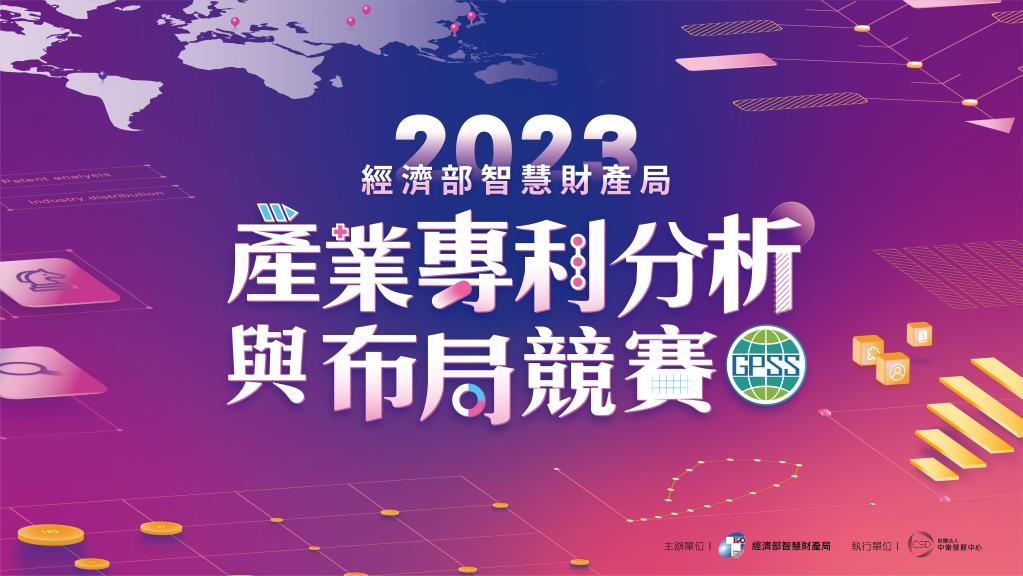 83
83The 2023 Competition for Patent Portfolio Analysis Addresses Needs of the Industry
TIPO is hosting the third annual Competition for Patent Portfolio Analysis. To strengthen strategic patent portfolios for corporations, this year’s theme featured specific technologies designated by the industry. This is designed to help companies head hunt and explore their needs in order to foster and cultivate patent portfolio professionals for the industry and academia – creating a mutually beneficial arrangement. TIPO hopes that the competition will facilitate patent search and patent portfolio analysis to pave a future for domestic industry development. Registration is available from now until June 30. All those who are interested in strategic IP patent portfolios are welcome to sign up.The competition is conducted on the GPSS (Global Patent Search System) platform, where competitors can search for patents, analyze statistics and charts, and even build advanced technology functionality matrices directly on the platform to identify technology evolution and development trends and other important information. This helps companies build patent portfolios and develop competitive strategies.To encourage participation, TIPO is providing a monetary prize of NT$ 250,000 for the winning team, and will also offer nine hours of free educational training to competitors. Training will start with patent searches and dive into patent portfolio analysis to familiarize competitors with GPSS, with the aim of enhancing their knowledge and skills for patent search and analysis.TIPO is also offering two online warm-up seminars on May 11 (Thu) and 18 (Thu) before the competition, inviting patent experts with extensive practical experience to share on topics related to patent search analysis and industry patent portfolios. The aim is to share resources relevant to the competition with competitors for better preparation. We welcome all who are interested in patent portfolio analysis to join.Registration for the competition is available online. TIPO welcomes all interested persons to form teams of 3-5 persons and sign up for the competition. For more details about the competition, please refer to the competition website (in Mandarin): https://gpss.tipo.gov.tw/gpsskm/competition2023Come join us!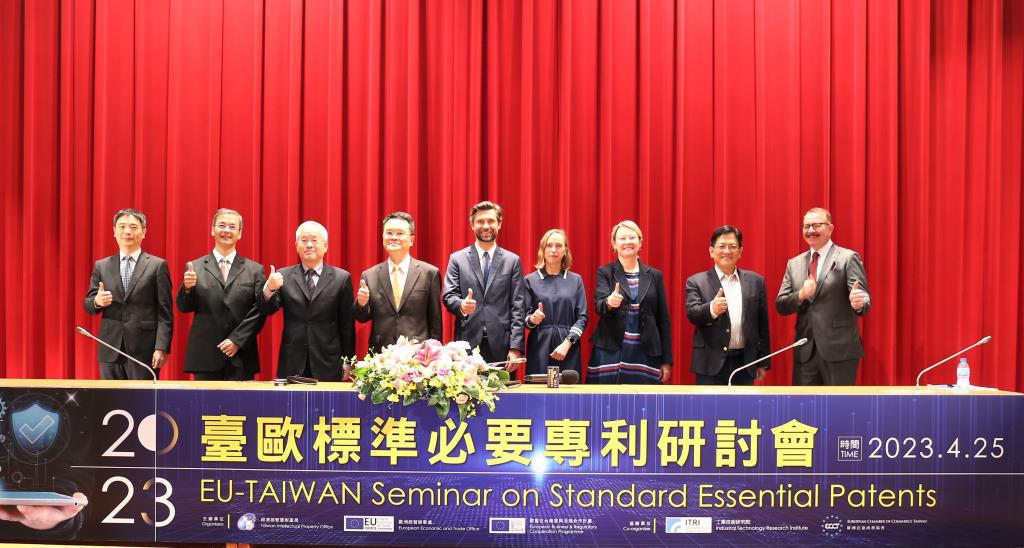 84
84The 2023 EU-Taiwan Seminar on Standard Essential Patents a Success Thanks to Everyone’s Participation and Support!
The Taiwan Intellectual Property Office (TIPO) has partnered with the European Economic Trade Office (EETO) and the European Business & Regulatory Cooperation (EBRC) to host the 2023 EU-Taiwan Seminar on Standard Essential Patents on April 25th, 2023, at the International Conference Hall, Tsai Lecture Hall, College of Law, NTU.The Seminar featured prominent speakers, including Anneli Andresson, Policy Officer at DG TRADE of the European Commission; John Eastwood, Co-chair at ECCT Intellectual Property Rights Committee; Hu Zu-shun, Director of the Department of Planning at the Fair Trade Commission; and Lai En-shang, a Patent Examiner at TIPO. They shared their insights on various topics such as the Development of Standard Essential Patents of EU, Standard Essential Patents and Anti-Suit Injunctions, Standard Essential Patents & Its Relationship with Competition Law, and Standard Essential Patents and Information Transparency: Assessing the Essentiality of Judgement Standards of SEPs. This seminar brought together 168 participants from the private sector, government agencies, and academia to exchange perspectives with experts from Taiwan and Europe, providing a valuable platform for active discussions and knowledge-sharing.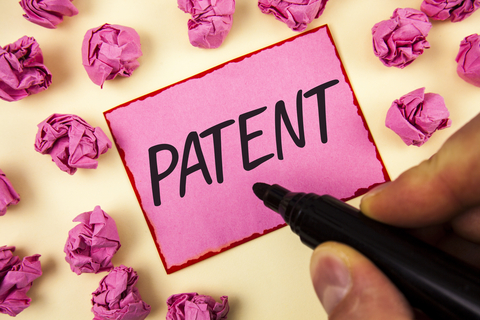 85
85Revisions to the Enforcement Rules of the Patent Act Shall be Enacted on May 1, 2023
Draft revisions to the Enforcement Rules of the Patent Act to meet patent examination needs and increase examination efficiency were promulgated on March 24, 2023. The revisions will take effect on May 1, 2023. A summary of key points are as follows:1. To determine whether any amendments are made in divisional applications, TIPO shall carefully review whether their subject-matter has extended beyond the content of the earlier application as filed. Applicants are required to attach a marked document indicating differences/changes in the application, with added parts underlined and deleted ones struck through, along with a relevant explanation of any and all alterations made, thus improving efficiency in the examination of divisional applications.2. In accordance with Article 27 of the Patent Act, if a biological material has been deposited in a depository designated by a foreign country in its territory with which Taiwan recognizes the effects of deposits based on reciprocity, and the certificate(s) of deposit issued by said foreign depository is submitted within the time period prescribed, the applicant is exempted from the requirement of making a deposit in Taiwan. Presently, foreign depository institutions that have been reciprocally recognized by Taiwan are international depositary authorities under Article 7 of the Budapest Treaty. These authorities shall issue documents that include certificates of deposit and viability statements, a practice that Taiwan also adopts. In order to promote mutual recognition of biological material deposits between Taiwan and other countries, documents issued by depositories not acquiring the status of international depository authority must include a viability statement.86
New Director General Cheng-Wei Liao and Deputy Director General Shu-Mei Li Take Office on March 27, 2023
Director General Cheng-Wei Liao obtained his Ph.D. in Biomedical Engineering from Chung Yuan Christian University. He has held various positions at TIPO since 2000, including patent examiner, Director of Patent Division I, and Deputy Director General. During his tenure, he successfully executed a patent backlog clearance plan, supervised the establishment of the Patent Search Center, promoted online patent examination, and proposed an inter partes review system for patent and trademark cases. He has also actively expanded cooperation with patent offices in various countries.Director General Liao possesses an extensive and diverse educational and professional background, a global perspective, and exceptional leadership skills.Deputy Director General Su-Mei Lee earned her Master's in International Studies from the University of Wyoming in the United States. She joined the Central Bureau of Standards (the predecessor of TIPO) in 1991 and has since held various positions, such as Trademark Examiner, Director of Trademark Division, and Chief Secretary of TIPO. With professional qualifications and extensive practical experience in intellectual property, Deputy Director Li has been recognized as a model civil servant by the Ministry of Economic Affairs for outstanding performance.The Taiwan Intellectual Property Office oversees critical aspects of intellectual property, including patents, trademarks, copyrights, trade secrets, and integrated circuit layout designs. To stay abreast of global industrial competition and align with industrial development, the office is committed to proactively building partnerships with inventors, academia, research institutions, and enterprises. It aims to enhance the protection and licensing mechanisms for creative works, promote substantive exchanges and collaboration with IP agencies worldwide, and establish a robust intellectual property protection environment in Taiwan.87
TIPO Statistics Report: Patent and Trademark Applications in 2022
In 2022, overall patent applications slightly decreased by 0.8% to 72,059 cases. Of these, invention patent applications (50,242 cases) grew by 2%, while utility model (14,662 cases) and design patent applications (7,155 cases) decreased by 7%, respectively. For trademark applications, 94,778 cases were filed, covering a total of 122,320 classes. As to examination efficiency, the average first action pendency was 8.8 months for invention patent applications and 5.2 months for trademark applications.Resident invention application number remained stableIn 2022, invention patent applications (19,400 cases) slightly decreased by 0.8%, mainly due to the declines in filings from individual and research institute sectors. Meanwhile, applications by corporations and educational institutes saw a growth of 1% and 7%, respectively. However, there was a moderate decrease in utility model (13,669 cases) and design applications (3,411 cases) by 6% and 3%, respectively, mainly due to the declines in filings from individuals and corporation sectors (Table 1), compared to the previous year.Japan claimed top spot in non-resident patent applicationsNon-resident applications for invention patents (30,842 cases) grew by 4%, while utility model (993 cases) and design (3,744 cases) patents saw declines (Table 1, Figure 3).A breakdown by applicant nationality shows that Japan continued to top the list with 13,128 overall applications (-1% compared to the previous year), followed by the US (8,517 cases, +7%) and mainland China (4,424 cases, +4%), while South Korea (2,775 cases) saw the highest growth at 16% among the top 5 countries. Japan also led in the number of invention and design patent applications, and mainland China surpassed other countries in utility model applications (Figure 4).Overall trademark application numbers remained fairly constant; growth seen in resident applicationsThe number of trademark applications totaled 94,778 cases (covering 122,320 classes) and marked the second highest number in the past two decades, preceded only by the records set in 2021 (95,917 cases, covering 123,217 classes). Notably, there was a 1% increase in resident (74,326 cases) and a 9% decrease in non-resident applications (20,452 cases) (Table 1, Figure 5, Figure 7).Among the top 5 trademark-filing countries or regions, mainland China (4,324 cases) took the lead, followed by the US (3,572 cases), Japan (3,546 cases), R. Korea (1,573 cases), and Hong Kong (1,120 cases). Applications numbers filed by mainland China and the US showed double-digit drops, while those from Japan were up 3% compared to last year (Figure 8).UNI-PRESIDENT ranked No. 1 resident trademark applicant in Taiwan for 3rd straight year, while IPPLUS TECHNOLOGY lead in non-residentsAmong resident applicants, UNI-PRESIDENT ranked first, with applications covering 834 classes, followed by WOWPRIME (189 classes) and KING CAR FOOD (163 classes). With regard to non-resident applicants, IPPLUS TECHNOLOGY claimed the top with applications covering 150 classes, followed by TENCENT HOLDINGS and JOHNSON & JOHNSON (both covering 94 classes) (Figure 9, Figure 10).With regard to resident trademark applications, Class 35 (advertisements and business operation) topped the list with 15,220 classes, followed by Class 30 (coffee, tea, pastries; 7,308 classes) and Class 43 (restaurants and lodgings; 7,206 classes). Furthermore, the COVID-19 pandemic has boosted online shopping, remote technology and video games, leading to a 7.5% increase in Class 41 (education; entertainment) and a 2.0% increase in Class 9 (computer and technology) (Figure 11). Regarding non-resident trademark applications, Class 9 led with 4,493 classes (Figure 12). With the exception of Class 42 (scientific and technological services), all application numbers for the top 5 classes decreased by 2% to 21%.Invention patent and trademark application pendency remained stableTIPO went full throttle to optimize examination quality and efficiency. As a result, the average disposal pendency was 14.3 months for invention patent applications and 6.5 months for trademark applications.88
Top 100 Patent Applicants in 2022
TIPO’s 2022 Statistical Rankings for Patent Applications and Grants reveals that TSMC maintained its position as the top domestic patent applicant for the seventh consecutive year, filing 1,534 applications. As for foreign applicants, Applied Materials secured the top spot for the first time, with a total of 881 applications. With respect to the numbers of patents granted for all three patent types, TSMC led the pack for domestic applications (1,196 patents granted), and Qualcomm was the most prolific foreign applicant (573 patents granted). TSMC ranked top among domestic applicants for 7th straight yearCompanies active in the semiconductor, display, and ICT industry sectors headed the list of top 10 domestic applicants. With 1,534 cases, TSMC has consistently filed the most applications since 2016. Acer (530 cases) and AU Optronics (505 cases) came in second and third, respectively. Mediatek’s application filing surged by 58% (412 cases), while Nanya Tech (371 cases) and Innolux (336 cases) each filed their highest number of applications over the last 10 years (Table 1).The top 100 domestic patent applicants filed 12,771 cases in 2022, a year-on-year increase of 4%. The number of invention (9,555 cases) and design patent applications (793 cases) were up 4% and 14%, respectively. The growth in applications was mainly driven by corporations and educational institutions. Furthermore, the filings in utility model patent applications (2,423 cases) also grew by 3% (Figure 1, Figure 2).Taiwan Cooperative Bank took lead; MEGA International Commercial Bank applied for the most invention patentsThere were six banks among the top 100 domestic patent applicants in 2022. Taiwan Cooperative Bank (220 cases) headed the list of patent applications, followed by the Bank of Taiwan (214 cases) and MEGA International Commercial Bank (205 cases), which also claimed the top position for bank invention patent applications (53 cases). Taishin International Bank (87 cases), meanwhile, made its debut on the list for the first time (Table 3).Among school applicants, Taipei City University of Science and Technology lead in overall patent applications, while National Cheng Kung University was most active in filing invention patentsTwenty-eight schools were among the top 100 domestic applicants for overall patents. Taipei City University of Science and Technology ranked first with 162 applications for the third straight year. Meanwhile, National Cheng Kung University (135 cases) claimed first place in school rankings for invention patent applications, followed by National Yang Ming Chiao Tung University (125 cases), National Tsing Hua University (108 cases), and National Taiwan University (77 cases) (Table 4).Industrial Technology Research Institute remained in top position for invention patent applications filed by research institutionsTwo research centers were also among the top 100 domestic applicants for patents across various types. The Industrial Technology Research Institute placed eighth in the overall rankings with 331 applications, while the Metal Industries Research ranked 41th with 87 filings (Table 5).Applied Materials headed foreign patent applicants for the first timeOn the foreign applicant front, the top 10 companies were mainly active in the semiconductor, ICT, and chemistry industry sectors. Applied Materials became the largest patent applicant with record-high 881 applications, while smartphone IC designer Qualcomm fell one notch to second place with 763 patent applications. Samsung Electronics took the third spot with 675 applications, the most it has filed in the last 10 years. Moreover, Meta Platforms Technologies (293 cases) and Shin-Etsu Chemical (275 cases) made their first appearance on the list for the first time (Table 2).The top 100 foreign patent applicants collectively filed 14,556 cases (+3%) in 2022, mainly driven by the rise in invention (13,069 cases) and utility model patent applications (181 cases), with growth rates of 6% and 22%, respectively (Figure 3).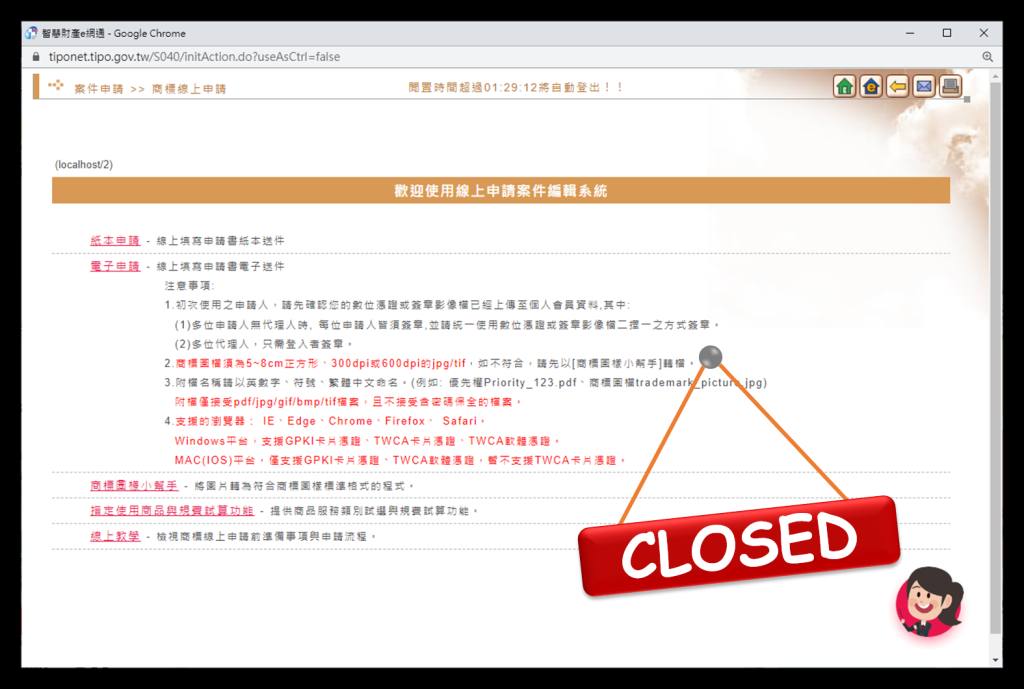 89
89TIPO’s New Trademark Online Application System Launched
TIPO launched the New Trademark Online Application System in 2022 to enhance the convenience of online trademark applications. The system offers a range of frequently-used application forms, such as those for graphic, color, sound, and three-dimensional trademarks, as well as certification marks. In addition, said system provides forms for various services, includingamendments, withdrawals, divisions, pre-registration changes, registration renewals, etc.As of December 2022, the new version of the system has achieved a utilization rate of 98.4%. The previous trademark online application system, launched in 2008, will remain closed indefinitely. For system-related assistance or suggestions, please email [email protected] 90
90Analysis of Trends in Trademark Applications Filed in 2017-2021
On November 21, 2022, WIPO released the latest edition of the World Intellectual Property Indicators 2022 (WIPI 2022), which provides information on various aspects of trademark worldwide for the year 2021, including the total number of applications and registrations, first OA and disposal pendency, final decision data, and application class counts per GDP and capita. TIPO analyzed trademark application trends for both foreign enterprises and industrial development of local counties and cities by referring to WIPI 2021 data and Taiwan’s trademark registration statistics from the past five years. The analysis evaluated the potential industrial development of Taiwan's industries by examining the classes of goods or services designated in trademark applications and compared them with global application trends. This analysis culminated in the report Analysis of Trends in Trademark Applications Filed in 2017-2021.The report indicates that the number of trademark applications worldwide in 2021 was nearly 14 million, covering over 18.1 million classes, with significant growth of 5.5%. Due to effective prevention measures and public cooperation with government policies, without any large-scale lockdown or stringent public quarantine measures, Taiwan's economy remained relatively unaffected by the impact of the pandemic and is currently in recovery. The report also shows a slight increase of 1.15% in the number of foreign trademark applications filed in Taiwan compared to the previous year.The Analysis of Trends in Trademark Applications Filed in 2017-2021 can serve as a valuable reference for the development of industry IP portfolios, brand building, and market trend forecasting.91
TIPO’s Q4 2022 IPR Statistics Report
In Q4 2022, TIPO received a total of 19,130 patent applications (including invention, utility model, and design patents), which remained steady compared to the same period last year. Among them, 13,370 invention patent applications were filed, marking a 3% increase. Trademark applications, on the other hand, stood at 22,890 cases with a drop of 8%. As for invention patent applicants, ITRI ranked first (213 cases) among resident applicants, outnumbering the others for the second year in a row; Samsung Electronics (212 cases) led all non-resident applicants. The top resident and non-resident trademark applicants were Cathay Life Insurance (128 cases) and FindSatoshi Lab (37 cases), respectively. Patent ApplicationsCompared to the same period (Q4) last year, overall patent applications (19,130 cases) received by TIPO saw a slight decrease of 0.4%. Of these, the majority were invention patents, with 13,370 cases and a 3% increase. Both resident applications (5,265 cases) and non-resident applications (8,105 cases) increased, with the former showing a higher growth rate (6%) compared to that of the latter (1%) (Table 1).As for resident applications, ITRI filed the most invention patent applications (213 cases), surpassing other applicants. Inventec (76 cases) registered a considerable growth rate of 171%. The number of applications filed by Mediatek (147 cases) and Nan Ya Plastics (64 cases) hit their decade highs (Figure 2).In terms of design patent applications, Acer filed the most applications with 40 cases. Getac (30 cases) and AUO Display (13 cases) entered the top 5 list for the first time (Figure 3).The number of invention patent applications from domestic enterprises (3,896 cases) and colleges and universities (541 cases) both grew by 10%.The number of invention patent applications filed by foreign applicants (8,105 cases) saw a small increase of 1% (Table 1). Japan filed the most with 2,942 cases (Figure 1). Among the top 10 applicants, Samsung Electronics leaped to the top of invention patent applications for the first time by filing 212 applications. The number of invention patent applications filed by Samsung Electronics, LG Display (82 cases), and Lam Research (71 cases) are at their all-time highs (Figure 2).As for design patents, Ford Global Tech came out on top with 44 applications. PSA (22 cases) saw a growth rate of 120%, and Japan Aviation hit a new record high with 24 applications, entering the top 5 list for the first time (Figure 3).Trademark ApplicationsCompared to the same period last year, trademark applications reached 22,890 cases (covering 29,252 classes) and saw a decrease of 8%, given a higher base period last year. The number of applications filed by residents (18,088 cases) and non-residents (4,802 cases) both decreased (Table 1).As for trademark applicants, Cathay Life Insurance filed 128 applications, outnumbering all other resident applicants (Table 2). Most of the number of applications filed by the top 10 applicants increased. In terms of the classes resident applicants filed under, most applications (3,734 cases) were filed under Class 35, “Advertising, Business Management, Retail and Wholesale Services, etc.” (Figure 4)Among non-resident applicants, mainland China filed the most applications (909 cases) (Figure 1). FindSatoshi Lab Limited, a company incorporated in the British Virgin Islands, ranked first among non-resident applicants with 37 applications, surpassing all others (Table 3). The number of applications filed by the top 10 applicants all saw positive growth. Regarding trademark classes, non-resident applicants filed the most applications (1,065 cases) in Class 9, “Computer and Technology Products, etc.” (Figure 5)The top 3 industry categories trademark applicants filed under were “Agriculture” (6,116 cases), “Business Services” (4,982 cases), and “Health” (4,595 cases). Most applications filed by residents were under “Agriculture” (5,243 cases), the majority of which were for the hospitality industries. On the other hand, most non-resident applications were filed under “Research and technology” (1,738 cases) (Figure 6).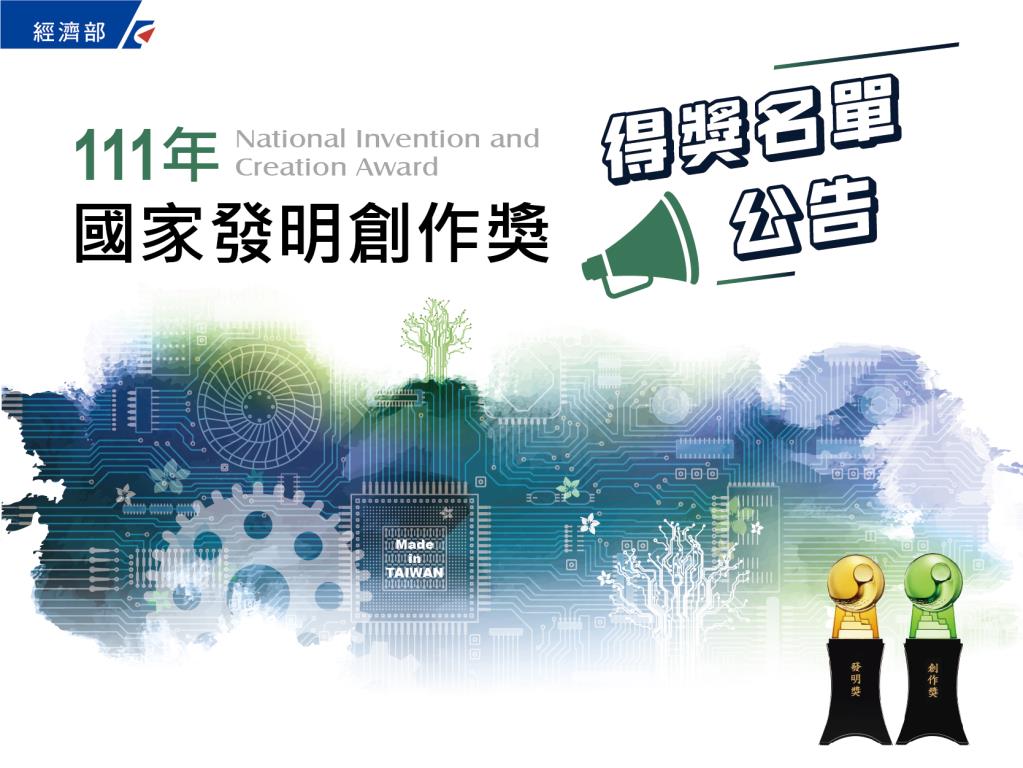 92
922022 National Invention and Creation Award Winners Announced
The National Invention and Creation Award recognizes creative endeavors and acknowledges the inventive contributions of its awardees. This year's winners, 43 outstanding entries in total, have just been announced and will share the total grant of $8.7 million NTD. Among the winners were 6 gold and 20 silver medals in the invention category, as well as 6 gold and 11 silver medals in the creation category. One of the gold medalists of the Invention Award presented the patent "Sport posture analysis system and method thereof," which uses built-in sensors in rackets to detect players' swinging motion, generating accurate, objective and efficient training data. This invention has been recognized by the International Table Tennis Federation and was utilized in the para-athletics classification system during the Tokyo 2020 Summer Paralympics.The Taiwanese government established the National Invention and Creation Award to encourage innovative research and development and honor exceptional invention, utility model, or design patents. The competition attracted a total of 459 eligible entries vying for the highest accolade, including 382 entries for the invention award and 77 for the creative award, showcasing active participation from industry, academia, and research institutions. Entries showcased unique innovations and applications in various technical fields and were evaluated fairly by being divided into groups based on their respective technical fields. Winners were selected through rigorous preliminary and secondary evaluations conducted by experts and scholars and will be awarded certificates, trophies, and prizes.TIPO highlights that many of the awarded patents have been successfully commercialized and patented in multiple countries, which indicates significant market potential. The winning patents span various industries, including "Liquid Crystal and Photonics," "Information and Communication," "Biotechnology and Medicine," "Medical and Industrial Materials," "Intelligent Machinery," and "Circular Economy." By recognizing the award winners, TIPO hopes to facilitate commercialization and industrialization of innovative R&D achievements, which play significant roles in Taiwan’s economic growth.The winners will receive their awards at the 2023 National Industrial Innovation Joint Award Ceremony in April this year. Their winning entries will be showcased at the 2023 Taiwan Innotech Expo from October 12-14, garner interest from both local and international investors, and generate business prospects for inventions and innovative works in Taiwan. 93
93Metaverse-Related Technology Analysis Report Published for Public Reference
The emergence of Metaverse is expected to drive significant advancements in extended reality (XR), digital service platforms, and internet technologies. To assist in understanding core technologies of the Metaverse, TIPO has analyzed 107,000 patents related to the Metaverse that were filed before 2021. Based on their structures and themes, 32 crucial patents have been selected and further analyzed to provide the latest insights on the core technology and patent trends in the Metaverse. This report also features suggestions regarding Metaverse patent application and examination for reference to the public.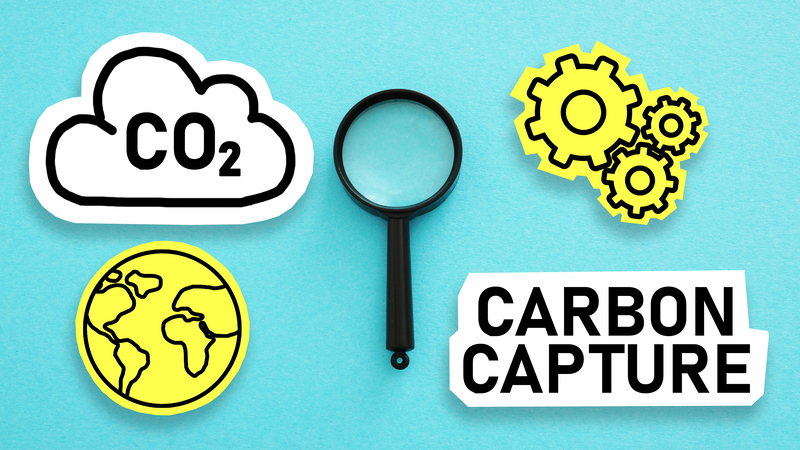 94
94TIPO Releases International Patent Trend Analysis Report on Carbon Capture Technology
Aimed at intensifying efforts to fight climate change, the Glasgow Climate Accord calls for a reduction in the use of coal and establishes the basic rules of the global carbon market. In line with this, the National Development Council of Taiwan published Taiwan’s Pathway to Net-Zero Emissions in 2050 in March last year, which identified "carbon capture, utilization, and storage" as one of its 12 key strategies.In response, TIPO is focusing on Carbon Capture, Utilization, and Storage (CCUS) and has compiled relevant patent information (published before the end of December 2021) from various countries. Said information will be subject to further analysis to provide a comprehensive view of overall patent trends, global patent filing trends for related technologies, and filing trends at major patent offices. Furthermore, TIPO will conduct a thorough analysis of the most frequently cited and industry-relevant patent cases related to carbon capture technologies in high-emission industries (e.g., petrochemicals, steel industry, etc.). Based on this analysis, TIPO will release the International Patent Trend Analysis on Carbon Capture Technology for public reference.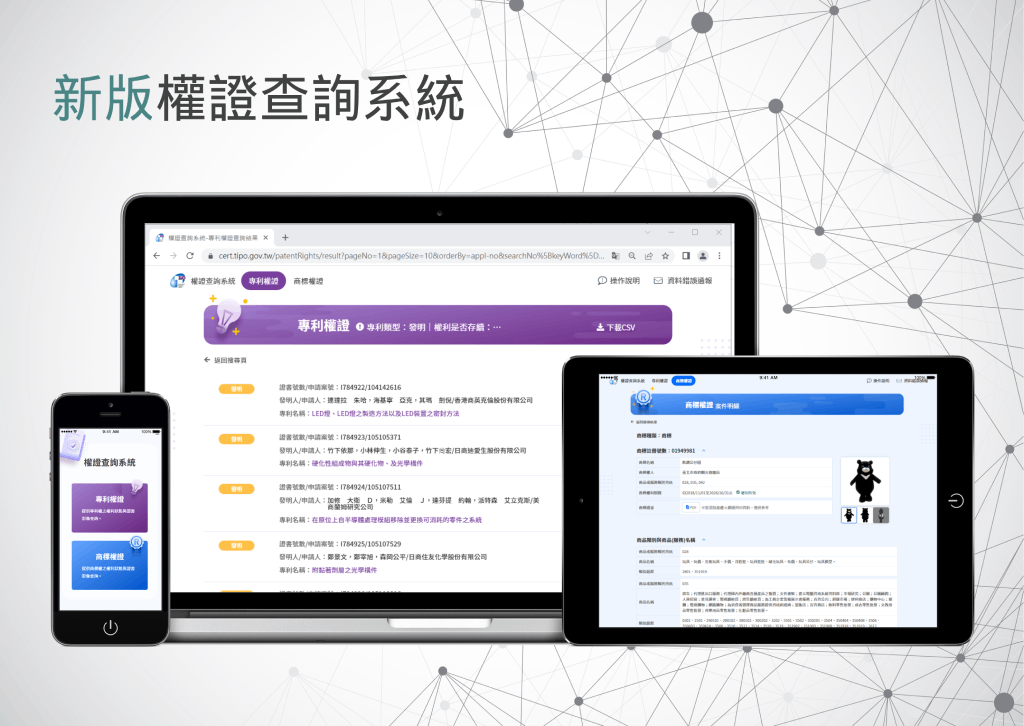 95
95TIPO Launches New Inquiry System for Patent and Trademark Certificates and Rights
TIPO has made available the "Inquiry System for Patent and Trademark Certificates and Rights" service since 2017, allowing users to search the latest rights status using an array of search criteria, such as certificate number, application number, rights holders/agents, publication date, and patent title or trademark name. Additionally, users can scan QR codes on patent and trademark certificates for immediate access to information.The Office has redesigned the website of the service with a focus on a user-friendly interface to improve efficiency and service quality. The new website features include the following:1. Optimized operation for enhanced convenience and mobile device compatibility.2. Unlimited search results per search, eliminating the previous display limit of 500 results.3. Customizable display of search result pages and number of results per page for ease of browsing.TIPO is pleased to announce the pre-launch of its redesigned website, developed to offer a more streamlined and user-friendly experience. The website is now open for a trial run - all interested parties are welcome to test out its features!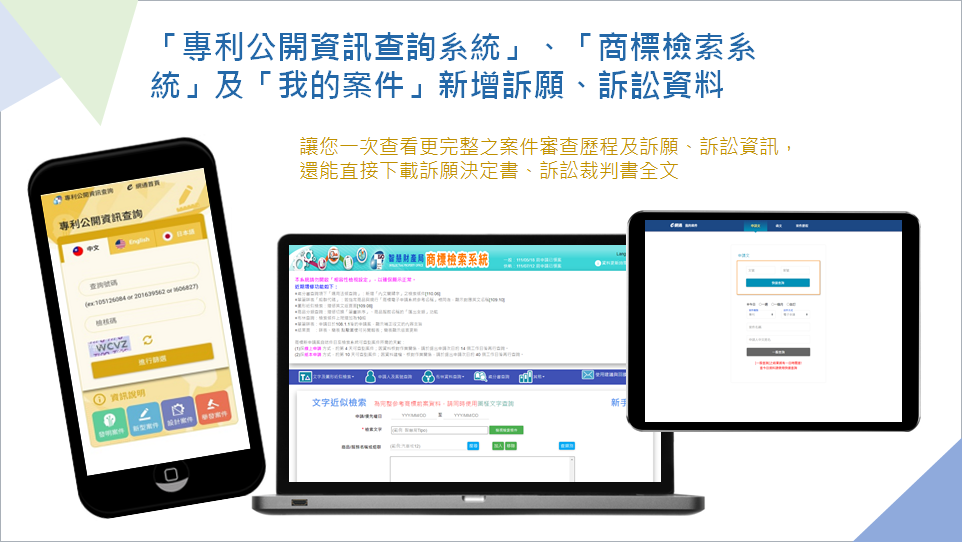 96
96TIPO Enhances Online Systems with Addition of New Administrative Appeal and Litigation Case Information
TIPO has collaborated with the Petitions and Appeals Committee of the Ministry of Economic Affairs and the Judicial Yuan to increase the accessibility of intellectual property information in Taiwan. As a result of this partnership, TIPO has integrated patent and trademark case information (including this year and the last five years) and litigation information (dating back to 2021) into systems such as "Patent Public Information Inquiry System", "Trademark Search," and the "My Filings" section on the e-Filing platform, allowing users to access complete case information. These services were officially made available to the public on December 19, 2022.Users can now browse administrative appeals and litigation information and download the full text of appeal decisions and litigation judgments directly. Additionally, the “Patent Public Information Inquiry System” has been optimized to provide a more convenient and intuitive inquiry feature. All parties are welcome to utilize these services.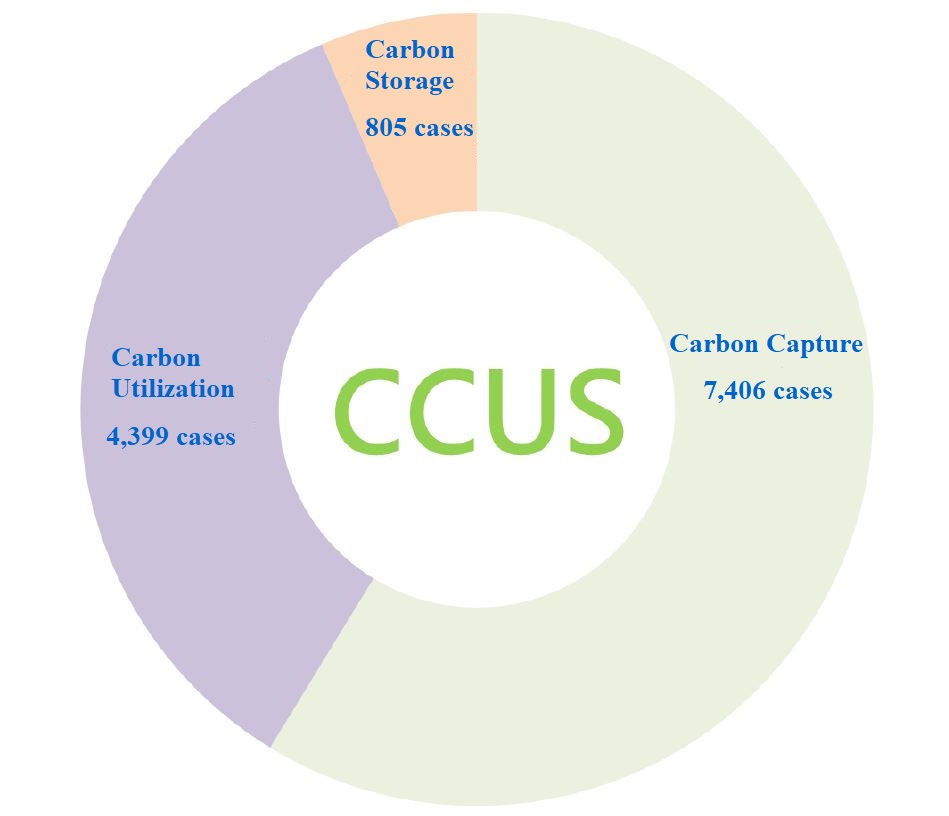 97
97CCUS in 2050 Net Zero Transitions – An Opportunity for Business Growth
Renewable energy plays a critical role in achieving carbon neutrality, and carbon capture, utilization, and storage (CCUS) is considered the final stretch towards net zero emissions. TIPO has compiled an analysis report on CCUS patent application trends and an overview of the patent landscape in this field for public reference.TIPO reports 12,610 global CCUS-related patent technologies (patent families), with 7,406 families in carbon capture, 4,399 in carbon utilization, and 805 in carbon storage – numbers continuously growing as the importance placed on addressing climate change increases. The Office’s analysis of the global patent landscape revealed a correlation between market sizes, level of importance placed on related issues, and number of patent applications. China, Europe, and the United States now have the record for the highest number of applications, most of them being local applications.Carbon absorption is the most prevalent and advanced technology among carbon capture methods, accounting for 39.1% of all related applications. Said method involves capturing carbon dioxide emissions using an absorbent. Adsorption technology, which accounts for 26.7%, is the next most prevalent, utilizing an adsorbent to bind carbon dioxide. Membrane separation technology, accounting for 12.5%, employs a thin film of organic or inorganic material to separate carbon dioxide from other gases. Although absorption technology continues to lead the field, there is an increasing trend in patent applications for adsorption and membrane separation, indicating that various companies and organizations worldwide are exploring a diverse range of carbon capture technologies.TIPO’s report highlights that despite the limited presence of patent applications for carbon capture technology in Taiwan, certain companies and research institutions are actively pursuing research and patenting said technologies. As an example, the Industrial Technology Research Institute and Taiwan Cement Corporation are collaborating to capture carbon dioxide through calcium looping process in order to reduce energy consumption and additional carbon dioxide emissions in the cement production process, demonstrating a leadership role in carbon capture technology.Carbon utilization technology has a broad range of applications, including the conversion of carbon dioxide into chemicals like methanol and methane, and even into novel carbon-based materials such as graphene, carbon tubes, and carbon fibers. Of the various methods for reusing carbon dioxide, the numbers of patent applications for converting carbon dioxide into methanol (11.4%) and methane (8.3%) are relatively high. Major companies, including CPC Corporation and Formosa Plastics Corporation, are investing in such technologies to boost competitiveness in the petrochemical industry. The China Steel Corporation has also leveraged its close proximity to local petrochemical companies and formed partnerships in steel and chemical co-production to optimize carbon capture and utilization/usage (CCU) benefits. Furthermore, with limited R&D in the field of novel carbon materials and a majority of investors being start-up companies, converting carbon dioxide into novel carbon materials could be a potential new business opportunity for SMEs in Taiwan.Applications for carbon storage technologies primarily come from countries or companies that possess oil and gas resources, with 48.1% of the applications focused on the technology of underground injection of carbon dioxide into reservoirs during oil and gas extraction. The implementation of carbon storage technology is limited in Taiwan due to the absence of natural gas or oil production, regulatory hurdles, and the requirement to gain consent from nearby residents for underground injections of carbon dioxide.As of recent, carbon pricing has been skyrocketing, and regulations are becoming increasingly stringent as countries move toward a consensus on reducing carbon emissions. TIPO emphasizes that industries should stay informed about the global CCUS patent landscape and proactively leverage their strengths and resources to research and develop new technologies so as to seize business opportunities in sustainability, leading to a positive impact on both the environment and the economy in the transition to a zero-carbon economy.For related information, please see:https://www.tipo.gov.tw/tw/cp-85-916712-4b1c5-1.html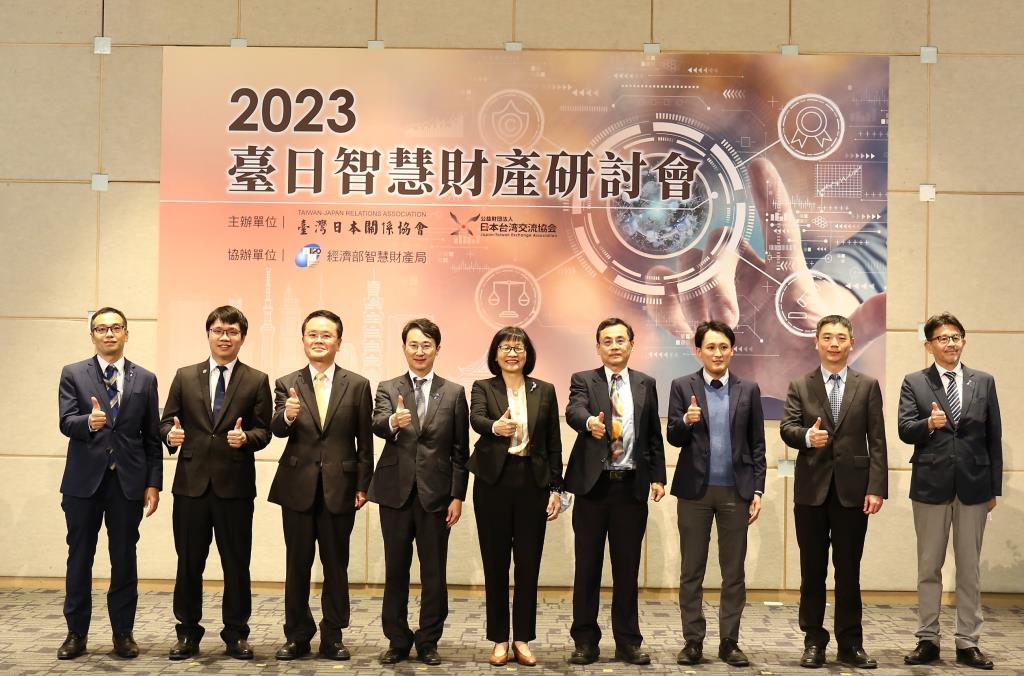 98
98The 2023 Taiwan-Japan Intellectual Property Symposium: A Resounding Success!
The 2023 Taiwan-Japan Intellectual Property Symposium, a collaborative effort of the organizers Taiwan-Japan Relations Association and Japan-Taiwan Exchange Association, in partnership with co-organizer Taiwan Intellectual Property Office (TIPO), was held on January 10th at the GIS MOTC Convention Center. It brought together an esteemed group of guest speakers, including Taiwan-Japan Relations Association Deputy Secretary-General Ching-Hung Lin, Japan-Taiwan Exchange Association Deputy Representative Dr. Takashi Hattori, Taiwan Intellectual Property Office (TIPO) Director-General Shu-Ming Hung, and Japan Patent Office (JPO) Policy Planning and Coordination Department Director-General Mikiharu Shimizu (remarks read on his behalf by Director Tauchi Koji of the Multilateral Policy Office, International Policy Department).The Symposium featured detailed presentations from JPO Multilateral Policy Office Director Tauchi Koji, TIPO International Affairs and Planning Division Director Chi-Hsien Chou, Wisdom International Patent & Law Office Registered Japanese Patent Attorney Kai Furihata, and Jou and Jou Patent Offices Patent Attorney Mike Jou. The speakers delved into the latest developments and initiatives of JPO, offered insights on the patent-related support measures provided by the Taiwanese government for enterprises to develop overseas markets, introduced the nuances of the Japanese invention patent system, and shared actionable strategies for applying and efficiently acquiring Japanese patent rights.Over 110 participants attended the 2023 Taiwan-Japan Intellectual Property Symposium, bringing together industry, government, and academia. The Symposium sparked a dynamic exchange of ideas and insights among participants and experts from both Taiwan and Japan, and fostered vibrant and engaging discussions throughout the event.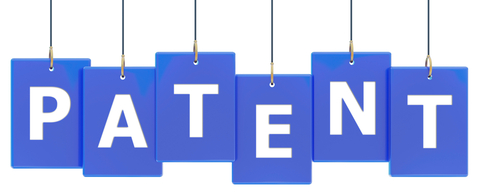 99
99Revisions to Part I of the Patent Examination Guidelines Come into Effect on December 1, 2022
TIPO has made revisions to Part I of the Patent Examination Guidelines regarding procedural examination and patent rights management. Main revisions are as follows:I. Chapter 1 - Procedures for Filing Patent Applications and Related Patent MattersElectronic signatures are on the rise. As the documents submitted for patent applications are primarily governed by private law, an electronic signature may be accepted as long as both parties can agree to the validity thereof. TIPO has therefore revised "1.2.4 Signatures for Electronic Documents" to relax requirements for signature formats. The signee only needs to provide a form of signature (whether it be a signature, stamp, or electronic signature) that matches the signature on the application documents.II. Chapter 3 – Patent ApplicantIn accordance with adjustments made to procedural examination, revisions have been made to “3.1 Inventor Change," "4.1 Applicant Name or Title Change," "4.5 Inventor Name Change," and included case studies to help the public better understand the principle of examination. The revisions also specify that applicants who are able to rectify inconsistencies on documents submitted with their applications do not fall under this category. In accordance with a judicial ruling, TIPO also included a case study explanation regarding name changes for different applicants who belong to the same entity.III. Chapter 5 – Filing DateThe establishment of the filing date is closely tied to the patent applicant provided on the application. To clearly stipulate that the cause for decisions on postponement of the filing date, revisions were made to “1.1 Application” for further clarification. The three relevant scenarios were also listed as "Change in Applying Entity," "Addition of Listed Applicants," "Decrease in Listed Applicants.”VI. Chapter 7 – Patent Priority and Grace PeriodAdded an example of incorrect priority document to the “1.5 Documentation and Submission Timelines for Priority.”V. Chapter 8 - Deposit of Biological MaterialsAdded revision to "4. Documentation for Deposit of Biological Materials" stipulating that a depository not an international depositary authority (IDA) under the Budapest Treaty must include viability information as required documentation.VI. Chapter 19 – Change of Patent RightsRevised “6. Recordation of Pledge Establishment ” and “6.2 Requisite Application Documents” in accordance with changes to Article 67 of the Enforcement Rules of the Patent Act announced on October 20, 2022.VII. Other RevisionsRevisions to all other chapters made in accordance with the relevant revisions to official regulations and procedural examination.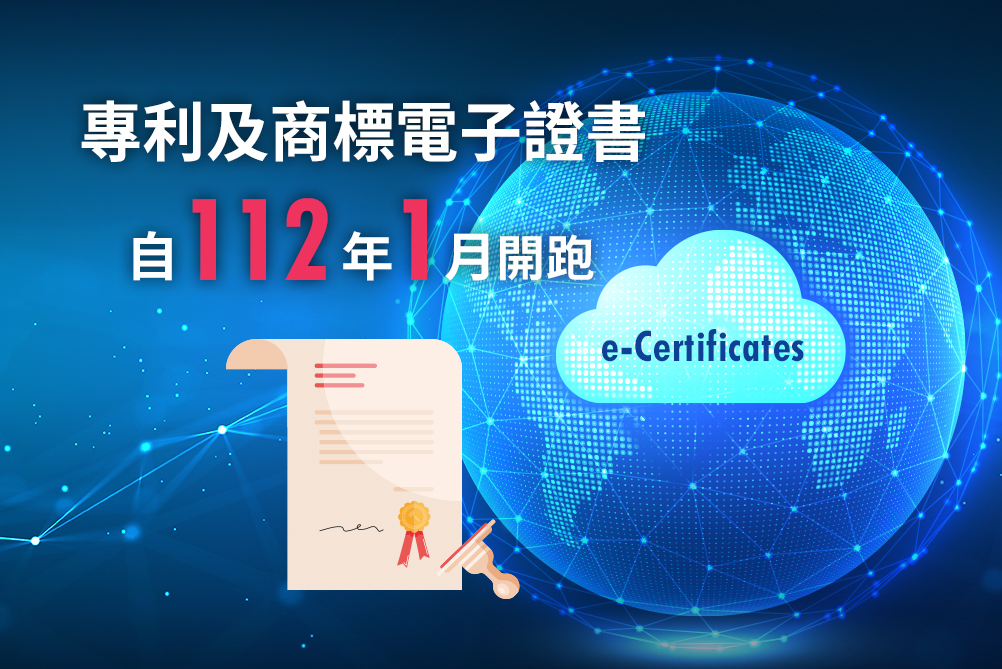 100
100New Upgrades to TIPO’s Digital Services – Online Certificates for Patents and Trademarks Available from 2023
To ensure TIPO offers more comprehensive digital services that better align with global trends, TIPO plans to offer online certificates for patents and trademarks from January 2023. The paperless process will make it more convenient for right holders to obtain and save their certificates, as well as reduce the cost of printing and mailing paper copies – a beneficial step towards achieving sustainable development goals of conserving energy and reducing carbon emissions.For the applicant’s convenience, TIPO will not make online certificates mandatory for all. The applicant may choose either an online or paper certificate when requesting their patent certificate or paying trademark registration fees. Should the applicant require a paper certificate later on, those who choose to receive an online certificate may apply for a paper copy.Upon receiving notification from TIPO that their certificate has been issued, applicants can download the online certificate by entering their verification code at the specified site within six months. Applicants may also obtain their online certificates through the E-SET e-delivery system. Afterwards, applicants will be able to access their online certificates on the e-portal with their digital certificate, under “My Applications.”TIPO's online certificates will be provided via PDF formats for easy circulation. The online certificates will be equipped with anti-counterfeiting measures that require verification and digital signatures, as well as a QR code. Right holders may upload digital files of their certificates onto TIPO's system or scan the QR codes to quickly verify the authenticity of their patent certificates, as well as access any updates to the status of their rights.

 Sitemap
Sitemap FAQs
FAQs Feedback
Feedback Bilingual Glossary
Bilingual Glossary